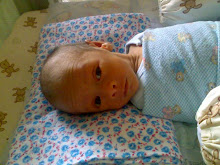
Can you see me clearly, baby?? Let's hear from his 'sight'..
Sight
From the day your baby's born, his eyes will aid his physical, mental, and emotional development by allowing him to take in information — a little bit at first, and eventually much more — about the world around him.
When it develops
Unlike a baby's hearing, which is fully mature by the end of his first month outside the womb, the sense of sight develops gradually over 6 to 8 months, at which point your baby will see the world almost as well as you do.
While your newborn's eyes are physically capable of seeing just fine at birth, his brain isn't ready to process all that visual information, so things stay pretty fuzzy for a while. As his brain develops, so does his ability to see clearly, giving him the tools he needs to understand and manage his environment. Though your baby starts out life being able to see only as far as your face when you hold him, his range of clarity grows steadily, month by month.
How it develops
At first your baby can't focus farther than 8 to 15 inches away — just far enough to make out the face of the person holding him. He can detect light, shapes, and movement beyond that, but it's all pretty blurry right now. Appropriately enough, your face is the most fascinating thing to your baby at this age (followed by high-contrast patterns such as a checkerboard), so be sure to give him plenty of up-close time.
1 month
At birth your baby didn't know how to use his eyes in tandem, so they may have wandered randomly or even crossed now and then. This month or next, he'll be able to consistently focus both eyes and track a moving object. A rattle passed in front of his face will often transfix him as he explores this newfound ability. He may also enjoy playing eyes-to-eyes with you: With your face very close to his, move your head slowly from side to side, with your eyes and his eyes locked.
2 months
Your baby could see color from birth, but he had difficulty distinguishing similar tones, such as red and orange. That's one reason he preferred black-and-white or high-contrast patterns. For the next few months, his brain's at work learning to distinguish colors. As a result, he'll probably begin to show a preference for bright primary colors and more detailed and complicated designs. Encourage this development by showing him pictures, photos, books, and toys. For the next couple of months, he'll also be perfecting his object-tracking skills.
4 months
Your baby's beginning to develop depth perception. Until now, it was tough for him to locate an object's position, size, and shape, then get a message from his brain to his hand to reach out and grasp it. At 4 months, he has both the motor development to handle the task and the maturity in his brain circuitry to coordinate all the moves needed to accomplish it. You can help him practice by offering him easy-to-grasp toys like rattles (otherwise he'll go for your easy-to-grasp hair, glasses, or earrings).
5 months
Your baby is getting better at spotting very small items and tracking moving objects. He may even be able to recognize something after seeing only part of it. This is evidence of his budding understanding of object permanence (knowing that things exist even when he can't see them at the moment), which is why he loves to play peekaboo. He can probably distinguish between similar bold colors and will start working on more subtle differences in pastels.
8 months
Your baby's vision — previously about 20/40 at best — is almost adult in its clarity and depth perception at this point. Though his attention is more focused on objects that are close by, his vision is strong enough to recognize people and objects across the room. His eyes are probably close to their final color, though you may see subtle changes later.


























































































